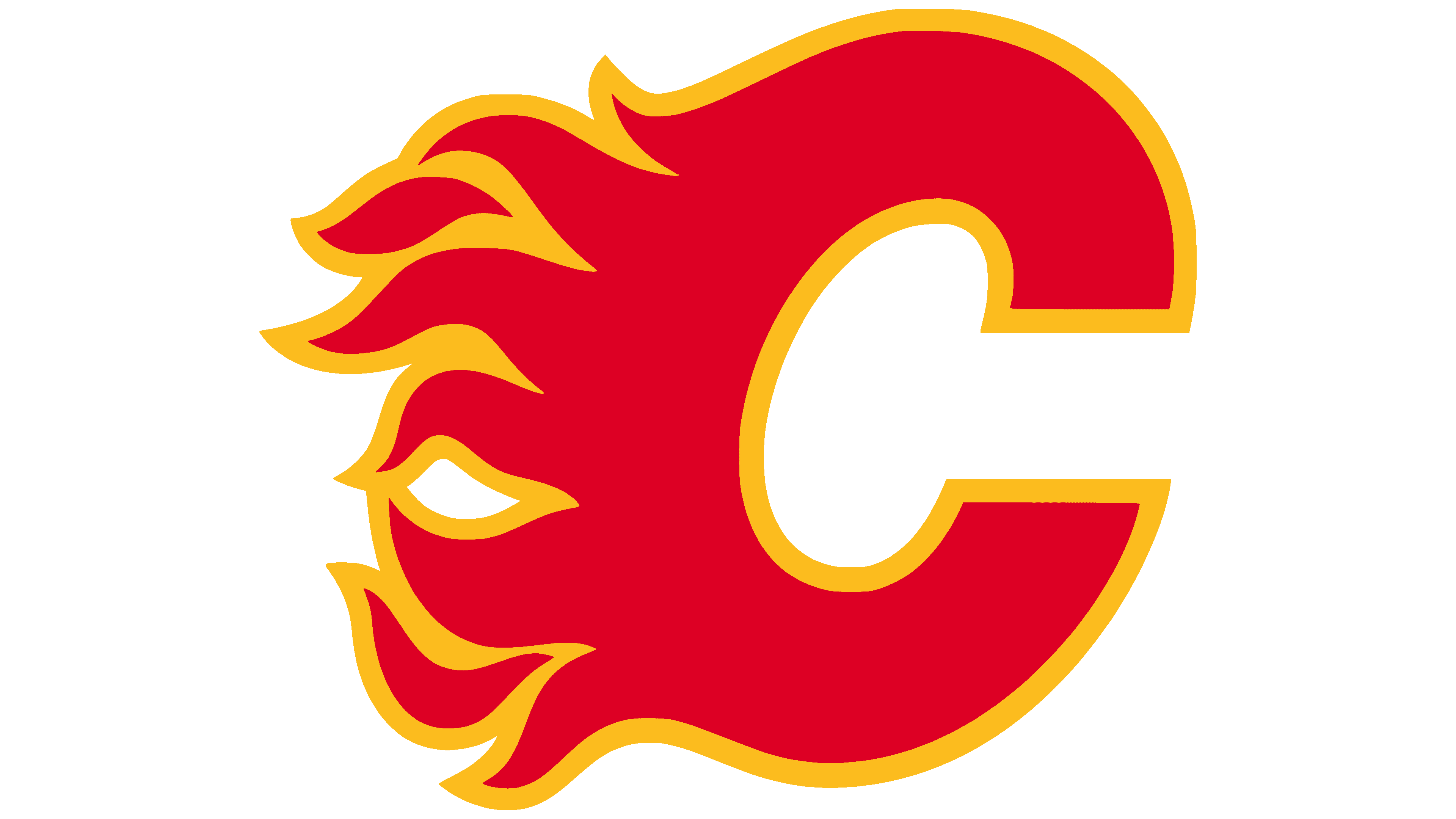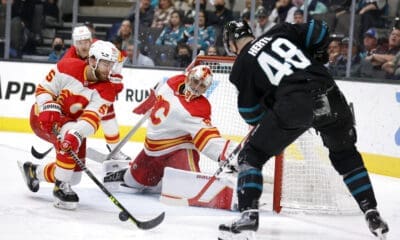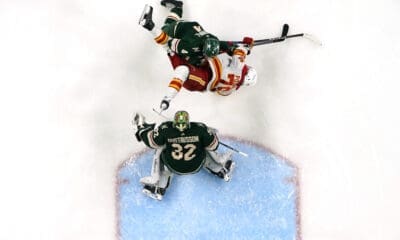Calgary Flames
2014-15 season quarter mark: A look at the Calgary Flames 20 games in
We're about a quarter through the season. How does the team compare to the rest of the league? How are the players doing?

Remember when the Flames finally traded Jarome Iginla, signalling the launch of their long awaited rebuild? More importantly, remember what Oilers fans were telling us? “I actually feel sorry for you guys.” “It’s going to be rough.” “Get ready for years and years of misery.” Those sentiments and more like them rang out up and down the QE2. They have not come true.
The Flames were a pretty fun team to watch in the first year of their rebuild. They weren't exactly great, and they lost more than they won, but still, they were fun. They rarely got blown out, and 49 one-goal games gave them a possible, if not unrealistic, fighting chance most of the season.
We're now about a quarter of the way through year two of the rebuild, and it's probably safe to say absolutely nobody saw this performance coming.
So far, the Flames have dressed 28 players this season. Six of them (David Jones, Mason Raymond, Matt Stajan, Mikael Backlund, Joe Colborne, and Michael Ferland) have been placed on injured reserve at one time or another. There have been five call ups (Josh Jooris, Markus Granlund, Michael Ferland, Sven Baertschi, and Max Reinhart). Five rookies (everyone in the previous list, just swap Johnny Gaudreau for Baertschi) have all played so far this season.
The Flames are second in the Pacific Division. They are third in the Western Conference. They are sixth in the league. They are third in the league with 63 goals scored, and 17th with 53 goals against.
Twenty-two teams have played fewer games, though. So when we adjust for that, the Flames are third in the Pacific Division, fifth in the Western Conference, and ninth in the league. They are also tied for fifth in the league with 3.05 goals per game, and tied for 14th with 2.60 goals against per game. Also, the Flames' powerplay is scoring at a 20.3% clip, good for 10th in the league, and the penalty kill is only successful 75.4% of the time, 25th in the league.
That's mostly, uh, very, very good. Like, that would be good in general, let alone where this team was expected to be this year.
Now, is it going to last? Sadly, we shouldn't count on it. As of right now, the Flames are 28th in corsi for (45.37%), 27th in fenwick for (46.55%), and third in PDO (102.79). Simply translated, that means most of the time, the Flames don't have the puck, and through their first 20 games, they've experienced above average luck in their favour.
They are second in the league in on-ice shooting percentage (11.66%), and 15th in on-ice save percentage (91.13%). So the goaltending and defence are going rather well (thank you based Jonas Hiller, Karri Ramo, TJ Brodie, and of course, future Norris winner and guy who should at least be a Hart finalist, Mark Giordano), but don’t be surprised if the scoring dries up. We weren’t expecting that much scoring out of this group anyway, right?
I'm a pessimist, so I like to look at things this way: Always expect the worst. That way you'll never be disappointed, and everything else will be a pleasant surprise. And a quarter into the season, the Flames are the most pleasant of surprises. We're all enjoying this, and we dang well should be.
So, what about the players?
Yes! What about the players? To date, there's been 26 skaters dressed. Thanks to the excellence that is stats website War on Ice, we have nifty charts we can use to give us a better visualization.
If you aren't familiar with how these charts work:
So basically, if you're a tiny red circle to the lower right of the chart, that means you play easy minutes and you don't play them very well. But if you were a big blue circle to the upper left of the chart, then that means you're playing tough competition in tough circumstances and thriving.
The Flames are a poor possession team, as stated above, so there isn’t much blue to see here. Sean Monahan, Jiri Hudler, and to a lesser extent, Curtis Glencross have been the only guys outshooting the opposition, although there are a couple of guys like Gaudreau, Giordano, and Brodie who are hovering around the 50% mark.
Let's be fair to the team, and swap corsi% for corsi rel%. This way, nobody is punished for playing on a bad team; we're comparing the team's players against one another, not the entire league.
That's a little nicer! Here are some simple observations about how the players have been used this season, and how well they've done in their roles. Let's start with the forwards:
- Monahan and Hudler are two of the team’s strongest forwards. They start in the offensive zone more often than not, but they’re also playing top competition. This is especially encouraging in Monahan’s case. Compared to his rookie season, his circumstances have gotten tougher, but he’s also performing better.
- Glencross is up there as well. His possession stats aren’t as strong, but he plays in tougher circumstances than the two aforementioned forwards.
- Gaudreau and Devin Setoguchi are sheltered, but have been good for the Flames. Gaudreau starts in the offensive zone more than any other player, and while Setoguchi often seems ineffective, he isn’t hurting the team. TJ Galiardi was actually similar to that last season, although his possession stats weren’t as good, but he was less sheltered.
- Raymond starts fairly often in the offensive zone, and faces a lesser quality of player. The Flames are marginally better at controlling the puck with him off the ice, but he’s been gone for 10 games now, and over those 10 games, the Flames have gotten better. He isn’t outstanding, but he’s capable.
- Colborne and Granlund face relatively tough competition and start in the offensive zone less than half the time. They tend to get outshot relative to their team. Granlund is a rookie forced to play time he wouldn’t otherwise have if it weren’t for injuries, while Colborne is a 24-year-old sophomore who bounces between the wing and centre. Being out-possessed isn’t optimal, but it’s understandable (especially for Granlund, and I’m sure Hartley would give him easier minutes if he could), and at least they aren’t playing buttery soft circumstances in the process.
- Jones hasn’t been bad at all. He faces some of the toughest competition on the Flames, and starts about 40% of his shifts in the offensive zone. Even with those challenges, not to mention the challenge of being seemingly constantly injured, he’s ultimately been positive for the Flames. He’s an easy player to pick on, and his salary isn’t justified, but at the quarter mark, in the 10 games he’s played, he’s been a contributor.
- It makes sense Backlund and Paul Byron overlap. They’re similar players. Neither is necessarily a top scorer, but both drive possession while playing relatively tough minutes. They don’t get great zone starts, they face tough competition, and they come away in the blue. We can accept not every player on a team will provide scoring, but we often substitute that virtue for truculence. Screw truculence. We should be looking for positive possession. For example, Byron’s breakaway struggles are pretty obvious this early into the season, but he’s getting breakaways. And wouldn’t you rather have a player getting breakaways and not scoring than a player not getting breakaways at all?
- Check out Stajan, all alone on the far left. Without Stajan, the Flames’ centres are basically a 25-year-old Backlund and then a bunch of children. When healthy, Stajan was trusted in a shutdown role, and the fact that he comes away just a faint red suggests he was really, really good at it. That’s why Stajan is a useful player for the Flames. He provides security for the rookies by handling some of the absolute worst circumstances, and he doesn’t get overwhelmed.
- Baertschi has had a rough go of it, but even with his limited ice time in middling circumstances, he has been a positive player for the Flames. Maybe he won’t score constantly. But as long as he chips in now and then while being a competent player, isn’t that good? Not every first round pick is going to be Monahan quality. He’s played a lot less, but Sven’s stats are actually pretty similar to Johnny’s. The main difference is Gaudreau is a shiny new toy, while Baertschi’s entry level contract is about to run out.
- So much deserved love to Jooris this season. He surprised us all in September, and he continues to today. He doesn’t get great zone starts, he’s on the lighter end of competition, and he gets out-possessed, but as a 24-year-old rookie it’s perfectly understandable. He’s not expected to be a top six player, and he certainly isn’t being played in that role. Jooris is likely to end up a useful bottom six guy who can handle less than ideal circumstances and play above his head in case of injury. That’s not a bad thing to have.
- Lance Bouma is in a similar situation, but having been in the league longer, he’s trusted with way worse zone starts, which contribute to his being more out-possessed. He doesn’t play amazing competition, but he doesn’t have to. Bouma is another example of a useful fourth liner capable of playing above his level if needed.
- Reinhart isn’t getting a lot of time, and he’s playing relatively ideal circumstances: decent zone starts and easy competition. He’s getting out-possessed, suggesting the 22-year-old may need more time to develop.
- Brian McGrattan and Brandon Bollig, however, are 33 and 27, respectively. We’re past the point of “need more time” with them. There’s a reason this blog tends to be pretty against them as players: they barely play, and when they do, it’s the easiest competition available in relatively favourable zone starts. and they don’t perform well. Bouma and Jooris have the excuse of zone starts and tougher competition. Reinhart has the excuse of being a rookie. McGrattan and Bollig don’t get those. They’re simply bad players who are detrimental to the Flames and add no value outside of grit, which isn’t as vital a component as things like “scoring” and “not getting scored on”.
- Ferland has only played two periods, so he doesn’t show up here yet.
As for the defencemen:
- Deryk Engelland is the worst of the bunch. He receives decent zone starts, plays the easiest competition, and has the worst possession stats relative to all the other defencemen on the team. Considering his circumstances, there’s simply no excuse for him to perform as poorly as he does. It just makes an already absurd contract seem even moreso. I can’t see him finishing it in Calgary.
- Ladislav Smid isn’t having a great time, either, but at least he’s the defenceman starting most often out of the offensive zone. He hasn’t been great, but he hasn’t been the worst.
- Raphael Diaz, meanwhile, has marginally better possession stats than Smid, but is the beneficiary of more starts in the offensive zone. He’s also only played seven games. He is showing more potential than the other two, and should probably be dressed over Engelland at the very least.
- Dennis Wideman and Kris Russell are probably the defencemen in the most favourable circumstances. The competition they play is middling, but they get to start in the offensive zone more often than not, Russell in particular. They’re a faint blue, so they could be better, but they’re the Flames’ second pairing for a reason. Wideman scores more than his partner, but Russell controls the game a bit better.
- And then, of course, there are Brodie and Giordano, and their performance is nothing short of amazing. They play the toughest circumstances of all Flames: the most ice time, the toughest competition, and they start outside of the offensive zone more often than not. Despite that, they’re the Flames’ leading scorers, and are positive possession players relative to the rest of the team. And are very close to being positive possession players in general. The top pairing is responsible for much of the team’s current success. The Flames would be beyond screwed without them. You’re enjoying watching Flames hockey right now: those are the two you have to thank.
Hey, what about goaltending?
Yes! Let's briefly talk goalies. At the quarter season mark, Hiller and Ramo have performed well. Hiller has played double the games Ramo has (14 to 7), and has had the overall better performance thus far.
It’s a markedly improved tandem. Last season, the Flames were 28th in team save percentage. A quarter of the way into this season, they’re 15th. Our old friend Reto Berra has played six games, and has a .914 save percentage. That’s not bad, but Hiller has played 14 games, and is sitting at .920. His mere presence has definitely brought the Flames a few extra wins, most notably displayed in the Flames’ first matchup against Chicago.
Hiller's even strength save percentage is .937, good for seventh in the league among goalies with at least 10 starts. Ramo sits at the less prestigious .911, which still isn't bad, but a quarter into the season, Hiller has been an absolute godsend for the Flames.
The future
Maybe the Flames keep up their unsustainable percentages for the remaining 62 games, but it's more likely they don't. That isn't a bad thing, though, because there's a lot to look forward to as this team and its players keep developing.
At this point, Monahan and Brodie are outstanding young players, and key members of the core. Backlund and Byron are both young depth players who help the team in tough circumstances. Gaudreau is a budding force. Baertschi is a capable player, but he needs more ice time and more trust.
Granlund and Colborne are both still developing, and maybe they'll pan out, maybe they won't. Granlund's the younger of the two, and he's handling the increased circumstances and difficult competition very, very well, all things considered. His time will probably come. Colborne's a bit older, but still just a sophomore, so what happens with him remains to be seen, but potential remains.
Jooris and Bouma look like good depth NHLers who can handle poor zone starts decently well and chip in on the offence on occasion. If they're two members of the Flames' future fourth line, it's probably going to be a pretty decent fourth line.
And that’s only counting guys in the NHL right now. So no, this team isn’t going to be bad enough to draft Connor McDavid (although we can always keep our fingers crossed for a lottery win). But there’s still Tyler Wotherspoon, Emile Poirier, and of course, Sam Bennett waiting in the wings. What we may very well be looking at is a future young, deep forward group.
Definitely need more defencemen, though.
by Ari Yanover








